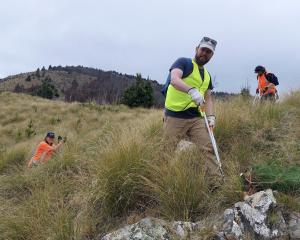An area of 680,000ha of South Island bush, including some Otago areas, is now significantly safer for birds, thanks to aerial application of 1080 poison, scientists say.
The Battle for our Birds initiative was launched by the Department of Conservation and TBfree New Zealand last year, to try to reduce the number of native birds killed by rats, stoats and possums.
Doc scientist Dr Graeme Elliott said 95% of rats and 85% of stoats had been eradicated, including in the Catlins and Clinton areas in South Otago, and the Dart River Valley near Glenorchy.
''The 1080 we used knocked the rats for six. It changed it from being an absolute disaster to a sort of moderate nuisance.''
A recent 1080 predator control briefing outlined the effect 1080 had had on predators and the research conducted around the toxin since its introduction in 1990.
Mr Elliott said a significant amount of bush where 1080 had been spread contained beech trees whose seeds contributed to rat, and subsequently, stoat numbers rising ''dramatically''.
Birds such as the South Island robin, rifleman and mohua had higher survival rate and nesting success now than in 2011.
''[It's] unequivocally more successful.
''A few birds were killed by 1080 ... but many more would have been killed by the rats and stoats that 1080 [killed].''
Mohua in the Dart River Valley now had a 90% survival rate, as opposed to a 60% rate in 2011.
Mr Elliott will present this information at this year's New Zealand Ecological Society Conference next week.
Landcare research wildlife ecologist John Innes said 10 million hectares of bush in New Zealand were under sustained control by 1080.
Between 1990 and 2014, five of six research studies on 1080 showed an increase in bird population and 79% of all research studies conducted showed a benefit to flora and fauna with the use of 1080.
It was important to remember no studies had been conducted on bird deaths as a result of aerial 1080, Mr Innes said.
Ban 1080 Party leader Bill Wallace, of Golden Bay, said statistics to do with aerial 1080 were Doc ''propaganda''.
''How can they claim an 85% success rate when they haven't counted the stoats?'' Mr Wallace said.
''I believe it's all manipulated figures.''
Mr Wallace gave a specific example of 25 of 39 tagged New Zealand rock wren being wiped out in the Kahurangi National Park last year as a result of 1080. He said it was a ''100% kill-rate'' on the Grange Range.
Official Information Act documents obtained by the Otago Daily Times from January state that 25 tagged rock wren were unable to be located after a specific 1080 drop. It was not known whether 1080 or a snowstorm was the cause.
''They [Doc] are now saying there are 66 [rock wren]. So it's a successful story. This is because they have been in there tagging every one they can find. It's an ecological disaster.
''It's us poor [people] that live in the country that get it dumped on our boundaries, year after year. Our dogs die. This is a horrific, cruel poison.''
A Doc spokeswoman said no plans were in place as yet for the next round of aerial 1080 drops and it would depend on the extent of beech tree seeding.
That would probably be known by February.












